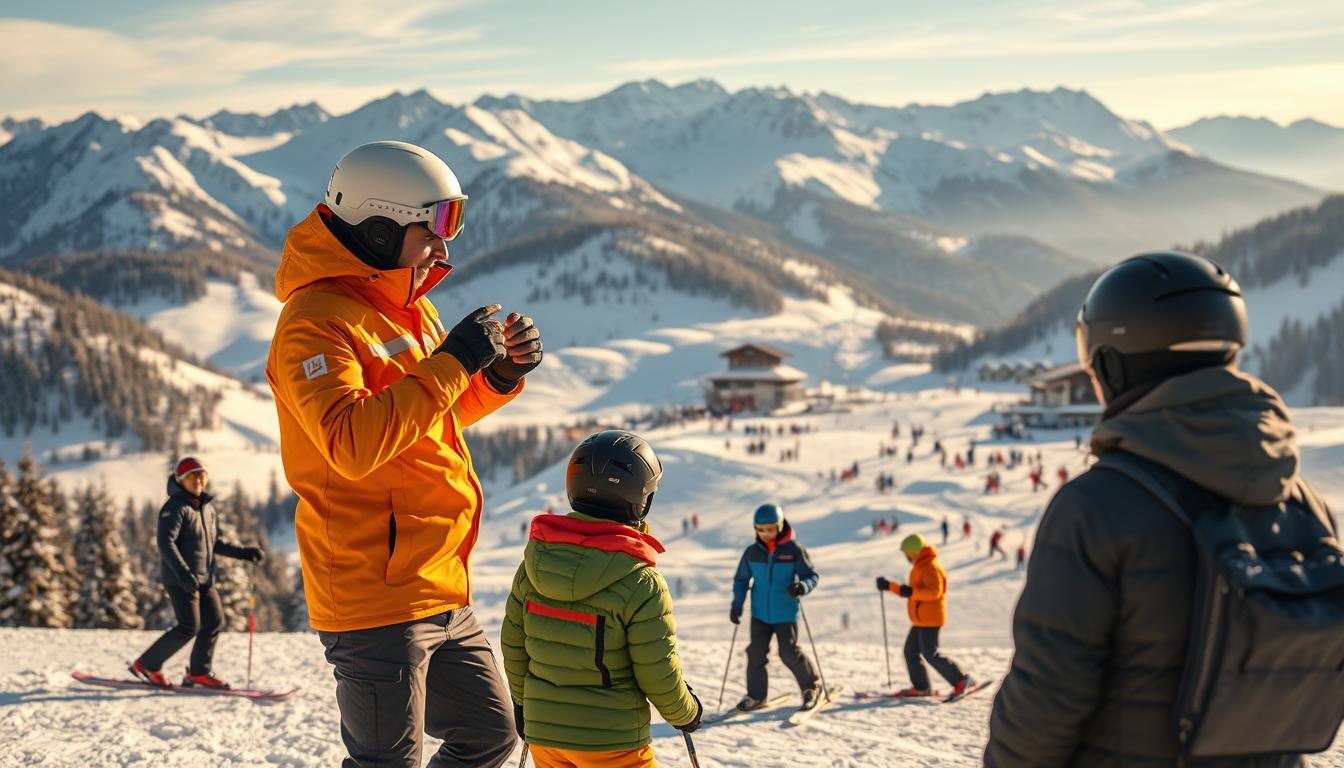Imagine spending your days carving fresh tracks, teaching eager learners, and living in iconic mountain towns like Lake Tahoe’s Palisades or Northstar. The ski instructor industry offers more than seasonal work—it’s a gateway to year-round adventure and tight-knit mountain communities. But here’s the reality check: thousands of applicants chase limited positions at top resorts every year.
This guide reveals what hiring managers actually look for beyond basic certifications. You’ll learn to craft a standout profile using tools like RoboApply, which uses AI to optimize resumes for resort-specific keywords. Discover how to highlight teaching potential, even if you’re new to professional instruction.
Major destinations now prioritize candidates who blend technical skills with adaptability. From navigating hiring trends to showcasing your unique value, we’ll help you turn your dream into a sustainable career. Ready to move beyond the “ski bum” stereotype and secure your place in this dynamic industry?
Key Takeaways
- Top resorts value teaching potential as much as technical skiing abilities
- AI tools like RoboApply boost application success through resume optimization
- Seasonal roles often lead to year-round opportunities in mountain communities
- Certifications alone won’t guarantee positions—storytelling matters
- Resorts prioritize candidates who adapt to diverse guest needs
- Networking within the industry creates unexpected career pathways
Overview of the Ski Instructor Career Path in 2025
The snowsports education field now demands more than passion for powder days. Certification bodies like PSIA/AASI and BASI set global standards, requiring instructors to master both technique and adaptive teaching methods.
Understanding the Industry Landscape
Major destinations like Lake Tahoe’s Palisades (6,000+ skiable acres) prioritize candidates with internationally recognized credentials. Most resorts now require Level 1 certification just to apply, with advanced roles demanding 3+ seasons of experience.
Career advancement follows structured tiers:
- Level 1: Entry-level positions teaching beginners
- Level 3: Specialized roles in adaptive skiing or race coaching
- Level 4: Trainer positions shaping resort instruction programs
Key Benefits and Seasonal Opportunities
Winter seasons typically run November-April, though heavy snowfall can extend operations. Lake Tahoe’s 2023 season lasted through July, creating rare summer teaching gigs at high-elevation resorts.
Beyond slope time, you’ll gain:
- Free season passes for personal skiing
- Discounted housing in mountain communities
- Pathways to year-round roles like ski school management
Resorts increasingly value cultural adaptability alongside technical skills. Successful candidates demonstrate patience with diverse learners – from toddlers to senior athletes mastering new terrain.
Essential Resume Strategies for How to Land a Ski Instructor Job in 2025

Your application materials are your first run down the mountain—make every turn count. Start with proven ski instructor resume examples that showcase technical expertise and teaching potential. Tools like RoboApply’s AI builder analyze resort job descriptions to highlight your most relevant qualifications automatically.
Crafting a Standout Resume and Cover Letter
Resorts receive 300+ applications weekly. Beat the pile with these essentials:
- Quantified impact: “Coached 80+ first-time skiers across 12-week season” shows measurable results
- Dual-certification edge: List both ski and snowboard credentials when applicable
- Safety first: Wilderness First Responder or avalanche training gets immediate attention
Use RoboApply’s cover letter generator to personalize each submission. Mention specific resort features like Vail’s EpicMix program or Aspen’s adaptive sports initiatives. One applicant landed interviews at 4 major resorts by tailoring letters with phrases like “Your commitment to eco-friendly slopes aligns with my Leave No Trace certification.”
Highlight transferable skills strategically:
- Summer camp leadership → Group management abilities
- Retail experience → Guest service expertise
- Language fluency → International client readiness
AI-powered templates help structure this information effectively. One hiring manager at Park City Mountain noted: “Candidates who demonstrate cultural awareness through their resume formatting get 40% more callbacks.”
Developing In-Demand Ski Instructor Skills and Qualifications
Mastering mountain instruction requires technical precision and strategic credentialing—here’s what separates qualified candidates from resort favorites. Certification systems like PSIA/AASI (USA) and CSIA/CASI in Canada use four-tier progression models. Level 1 unlocks beginner lessons, while Level 4 denotes expert status with trainer privileges.
Building Technical Ski and Snowboard Expertise
Resorts test your ability to demonstrate flawless parallel turns on black diamonds and powder transitions. Focus on three core competencies:
- Speed control through turn shape adjustments
- Balanced stance across moguls/steeps
- Equipment knowledge for varied snow conditions
Dual certification boosts opportunities—57% of Vail instructors teach both disciplines. Train through structured programs like NZSIA’s 11-day courses blending on-snow drills with teaching theory.
Supplementing Your Profile with Additional Certifications
Wilderness First Responder credentials make you 34% more hireable according to Jackson Hole hiring data. Prioritize these add-ons:
- Avalanche Safety Level 1 (American Institute for Avalanche Research)
- Freestyle Coach Accreditation (USASA)
- Foreign language proficiency (Spanish/French preferred)
Many candidates use tour guide resume templates to showcase complementary skills like group leadership. One Whistler hiring manager noted: “Instructors with race coaching certs get first dibs on private lesson bookings.”
Interview Preparation and Success Tips for Ski Instructors
Resort hiring teams assess more than technical prowess—they want instructors who connect with guests while maintaining rigorous safety standards. Your preparation should address both soft skills and slope-ready expertise.

Behavioral Responses That Showcase Teaching Skills
Anticipate scenario-based questions like “Describe how you’d help a terrified adult on their first chairlift ride.” Structure answers using the STAR method:
- Situation: “Last season, I coached a 7-year-old who froze on blue runs”
- Action: “I shifted to terrain-based learning on gentle slopes”
- Result: “They completed 15 successful turns by lesson’s end”
Practice simplifying technical terms. Instead of “angulation,” say “bend your knees like squeezing a beach ball.” Resorts value this skill—Vail’s training director notes: “Instructors who demystify movements get 30% more return clients.”
Highlight availability flexibility upfront. Mention willingness for early mornings or holiday shifts, crucial during peak season. Research each resort’s unique programs—knowing Breckenridge’s adaptive sports initiatives or Aspen’s family lesson structure shows genuine interest.
Prepare 2-3 stories demonstrating safety leadership. Example: “During avalanche protocol training, I identified risky terrain choices in three colleague lesson plans.” Use industry-specific interview frameworks to avoid common pitfalls.
Close with career vision statements: “I aim to earn Level 3 certification while mentoring new team members.” This approach helped one candidate land roles at both Park City and Taos Ski Valley despite limited teaching experience.
Utilizing RoboApply for a Streamlined Application Process
Competition for mountain positions requires more than passion—it demands precision. RoboApply’s suite of tools transforms scattered applications into targeted campaigns. You’ll manage multiple resort submissions while maintaining the personal touch hiring managers crave.
How RoboApply's AI Resume and Cover Letter Builder Can Help
The platform’s AI analyzes job descriptions from Vail Resorts to Mt. Bachelor, tailoring your materials to each mountain’s priorities. One user secured 3 interviews by highlighting avalanche training for Jackson Hole’s backcountry programs. The system auto-formats certifications like PSIA Level 2 into ATS-friendly layouts.
Cover letters become strategic assets, not afterthoughts. Input details about Breckenridge’s terrain parks or Deer Valley’s luxury clientele—RoboApply weaves them into compelling narratives. Pro Tip: Mention specific lift systems or teaching philosophies from resort websites to demonstrate genuine interest.
Exploring the ATS Optimizer and Outreach CRM
Resort hiring systems scan for 12-15 key terms per application. RoboApply’s optimizer ensures your resume includes phrases like “adaptive lesson planning” or “equipment troubleshooting” based on real-time data. Track applications across 20+ resorts using the dashboard, which flags overlooked follow-ups and expiring certifications.
The CRM helps nurture industry connections automatically. Schedule check-ins with Park City hiring managers or share updates with recent graduates entering the field. One candidate landed a Telluride position after the system reminded them to share new freestyle coaching credentials with their network.
Insider Advice on Landing Jobs at Top Ski Resorts and Navigating Visa Requirements
Securing positions at premier destinations requires strategic planning beyond basic applications. Top-tier ski resorts like Palisades Tahoe receive 500+ applications weekly—submit yours before October 1st for priority review. Non-US citizens should first explore working holiday visas (available through 35+ countries) enabling legal employment without sponsorship.
Global Opportunities and Strategic Applications
Cast wide nets across hemispheres. Apply to 20-30 resorts spanning North America, Japan, and New Zealand’s Southern Alps. Use RoboApply’s tracker to manage deadlines—one candidate received three job offers by coordinating applications across Whistler and Queenstown.
Prioritize smaller mountains for faster growth. Family-owned ski areas often provide better training than corporate giants. A Northstar instructor doubled their private lesson bookings within one season through this approach.
Visa success hinges on specialization. Resorts sponsor Level 2+ instructors with race coaching or adaptive certifications. For under-30 applicants, New Zealand’s working holiday program offers seamless entry—40% of international staff use this pathway.
Final tip: Update certifications early. Wilderness First Responder credentials expire annually—renewals completed by August ensure eligibility for prime winter roles around the world.
FAQ
What certifications do I need to become a ski instructor in 2025?
Most resorts require PSIA (U.S.) or BASI (Europe) certifications. Start with Level 1 credentials and consider specialized add-ons like adaptive skiing or freestyle coaching. Some regions accept CSIA (Canada) or NZSIA (New Zealand) licenses for international roles.
How can I make my ski instructor resume stand out?
Highlight teaching hours, student age groups taught, and terrain expertise (e.g., moguls, park). Use metrics like “Improved 85% of clients’ parallel turns within 3 lessons.” Tools like RoboApply’s AI Resume Builder tailor content to resort-specific keywords.
Do I need a visa to work at international ski resorts?
For non-citizens, countries like Canada and Japan often require working holiday visas or employer-sponsored permits. Apply early—New Zealand’s visa process can take 8+ weeks. U.S. resorts may sponsor J-1 visas for seasonal roles.
What interview questions should I prepare for?
Expect technical drills (“Teach a wedge-to-parallel progression”) and behavioral scenarios (“Describe resolving a frustrated student”). Resorts like Vail and Whistler often include on-snow demonstrations to assess teaching style.
How does RoboApply help with ski instructor applications?
RoboApply’s ATS Optimizer ensures resumes pass resort screening software, while its Outreach CRM tracks applications across 20+ platforms. The AI Cover Letter Generator adapts to resort values—like sustainability for Aspen Snowmass.
Are there year-round ski instructor opportunities?
Southern Hemisphere resorts (e.g., Cardrona in New Zealand) offer winter seasons June–October. Summer roles include glacier camps (Timberline Lodge) or mountain biking instruction at hybrid resorts like Park City.
What soft skills do resorts prioritize?
Top traits include conflict resolution (handling parent concerns), adaptability (weather closures), and cultural awareness. Deer Valley and other luxury resorts emphasize guest service experience in recent job postings.
Should I take a ski instructor course before applying?
Yes—certification programs like EA’s 11-week course in Whistler boost hiring chances. They provide hands-on training, exam prep, and job placement support. Many graduates secure roles at partner resorts within 30 days.
How competitive are jobs at major resorts?
Resorts like Jackson Hole receive 300+ applications per opening. Early applications (April–June for North America) and referrals from current staff improve odds. Highlight backcountry certifications or multilingual skills to stand out.
Can I teach snowboarding without a separate certification?
Most resorts require AASI Level 1 for snowboard instruction. Dual-certified instructors (ski + snowboard) earn 15–20% higher pay at destinations like Breckenridge and increase their marketability for private lesson bookings.


















